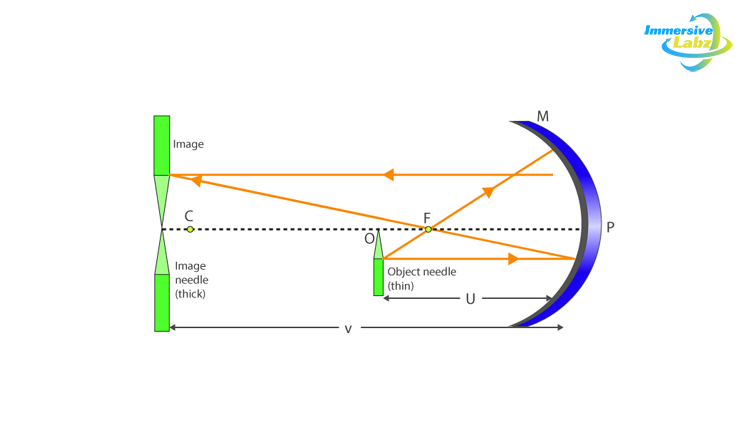Physics Practicals Class 12
Concave Mirror Focal length by u-v Method
- Perform science experiments at your fingertips
- Learn anytime and from anywhere
- 3D gamified way of advanced learning
- Boost your academic score
- Accessible through Mobile, Laptop, Desktop, and Tablet
- Gain a competitive edge in IIT and NEET exams
About Simulation
- In this virtual lab simulation, you will learn how the concept of a concave mirror is used in signal antennas.
- You will study the image formation by a concave mirror and represent it graphically by the u – v method.
- You will learn and apply the mirror formula to find the focal length of a concave mirror.
- This interaction provides a very immersive virtual environment and gives you a real-lab-like experience while conducting or performing experiments.

- All the concave mirror experiment steps and procedures like measuring the image distance, object distance, focal length of a mirror, noting down the readings, removing the parallax, etc., and many more are highly interactive and have been simulated in a very similar manner as you do in a physics lab.
- It is one of the important class 12 physics practicals that you can learn in our virtual lab.
- This will help learners to better prepare for various competitive exams such as IIT-JEE (JEE Main & Advanced), NEET, and Olympiads.
Simulation Details




Description
A concave mirror is one type of spherical mirror, which is a piece cut out of hollow spherical glass. It has a polished outer surface, and the other is reflective. It is also known as a converging mirror because it converges all parallel beams of light incident on it. Concave mirrors can form real images that are projected on them in front of the mirror at the focus point. Concave mirrors can be used in satellite dishes, vehicular headlights, astronomical telescopes, and more.
An object placed at a distance 𝑢 from the pole (P) of a concave mirror of focal length (𝑓), the image is formed at a distance 𝑣 from the pole (P).
The relation between distance 𝑢 & 𝑣 is $$\frac{1}{f}=\frac{1}{u}+\frac{1}{v}$$
The focal length of the concave mirror,$$f=\frac{u v}{u+v}$$
Requirements for this Science Experiment
⦁ Optical Bench ⦁ Uprights ⦁ Concave Mirror ⦁ Lens Holder ⦁ Optical Needles
Why Choose SimuLab for Science Practicals?

Image Gallery
Try SimuLab
A 3D virtual science lab (physics lab, chemistry lab, and biology lab) that helps students learn science experiments easily.















